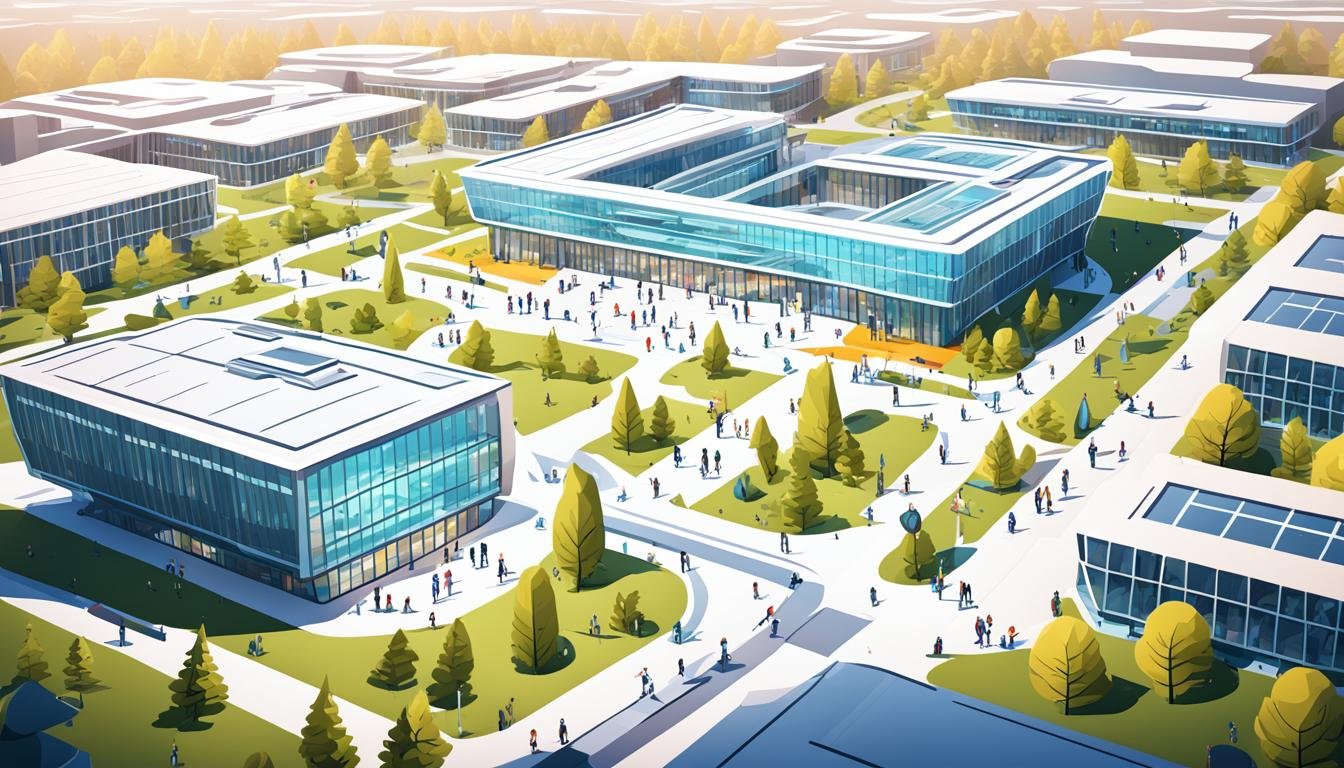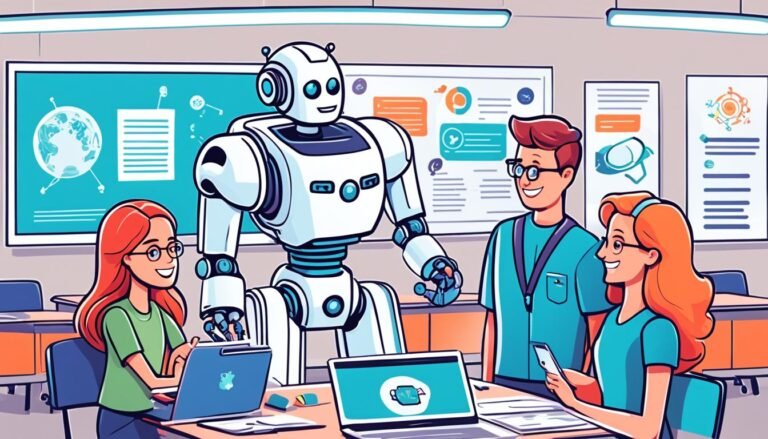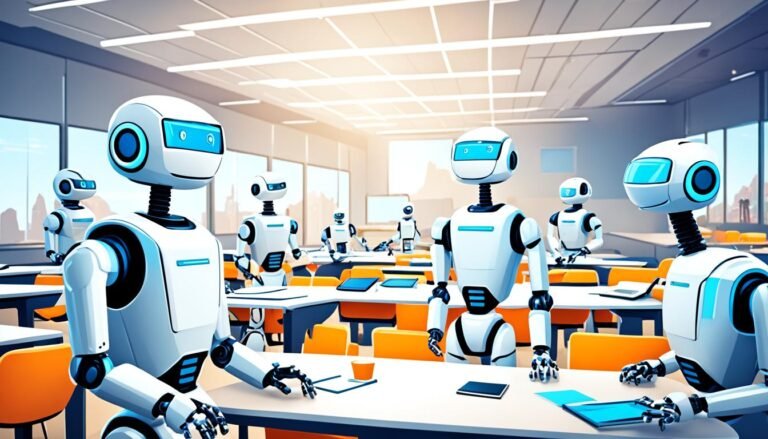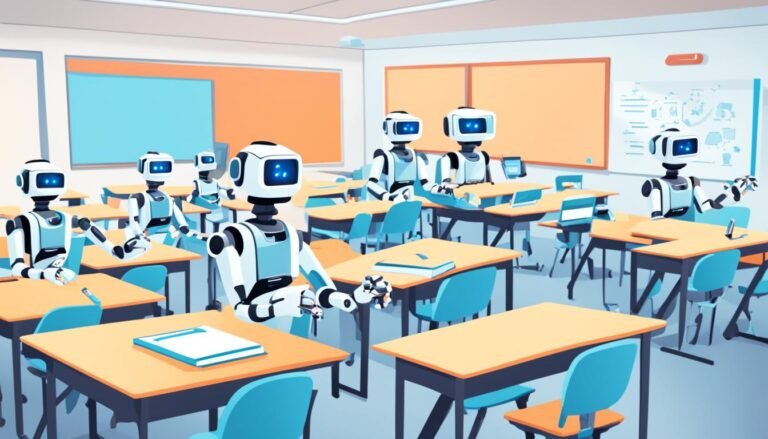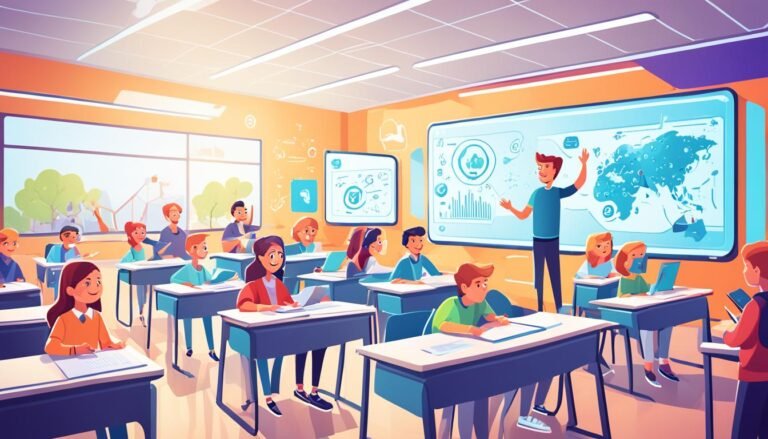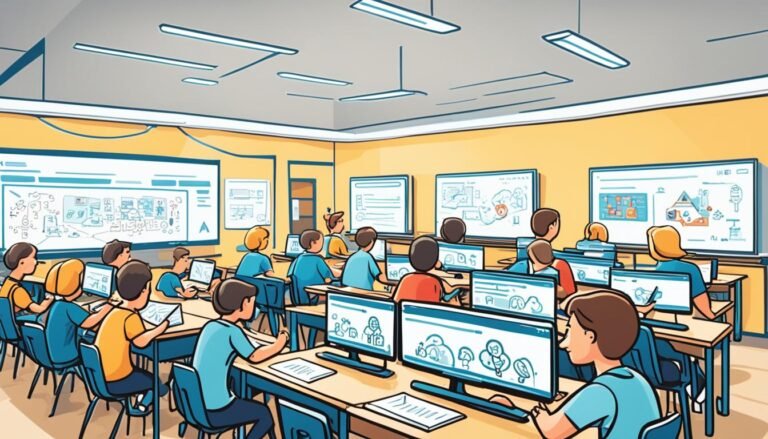AI in Higher Education: Transforming Learning
A brisk morning in November 2022 changed how we see education. OpenAI unveiled ChatGPT, sparking excitement and questions in universities. Educators wondered how this new AI tool would impact teaching and learning. Shortly after, on February 15, 2024, Sora was launched. This AI tool could turn simple text into amazing videos. It promised a new way to share educational content, but also raised ethical concerns.
AI is quickly changing higher education. It’s bringing tools like learning analytics and tutoring systems. These advancements aim to improve learning and teaching. But, there’s a big focus on using these tools in a good and fair way.
For teachers, students, and decision-makers, a new era of learning is here. It promises learning that’s personalized, fun, and efficient. Though the road is tough, we see lots of chances to change how we learn and teach.
Key Takeaways
- Launch of ChatGPT and Sora has sparked both excitement and concern among educators.
- AI-powered learning analytics and intelligent tutoring systems are set to transform higher education.
- Ethical considerations and disparities must be carefully managed in the AI-driven educational landscape.
- AI can help personalize learning experiences by analyzing student data and tailoring educational pathways.
- Innovative AI tools are revolutionizing content creation, student engagement, and administrative tasks.
Introduction to AI in Higher Education
AI’s role in higher education is vast. It brings changes from how we recruit to how we personalize learning with tools like machine learning. These advancements improve the quality of education a student can receive.
Machine learning is being integrated through courses like “Introduction to Artificial Intelligence (AI) for Higher Education.” These courses explain AI tools and their background. “Using Artificial Intelligence (AI) Effectively in Teaching and Learning” looks at AI’s role in teaching, learning, and ethics. Experts like Jackie Zkiab and Allison Hosier share their knowledge in these areas.
Adaptive learning is key. It includes AI personal helpers, apps for making video or voice content, and plans for custom learning. These tools are now central to student life. For instance, Intel’s AI for Workforce offers 500+ hours of content to help both students and teachers develop their AI skills.
Employers are looking for graduates skilled in AI. A 2021 survey found 69 percent of educators and IT officials see this need growing. Advanced AI in learning makes research more efficient. It upgrades how we discover new things and put them to use faster.
There are different AI types, each needing special tech and safety setups. Thanks to platforms like Microsoft Copilot and resources from Intel, AI is more within reach in higher education. They help students and teachers get ready for the future.
There are global efforts to use AI in education. Groups like the AI in Education Google Group and the “Learn with AI” toolkit from the University of Maine are examples. They work with UK groups to provide talks and webinars on AI in education.
Revolutionizing Recruitment and Admissions
Today, higher education is embracing AI for smarter recruitment and admissions. AI helps in many ways, such as refining how schools connect with future students. Let’s explore how AI changes these areas.
Targeting and Outreach
AI is key in higher education by looking deeply into big data. It spots patterns and predicts what’s coming. With this info, schools can reach out better to potential students. This step makes their efforts more focused and effective.
Application Processing
AI makes applying to college smoother by handling many tasks automatically. It can pull info from forms and transcripts fast. This helps everything move quicker. In fact, 55% of teachers say AI has made education better. AI can also check application documents for issues and ensure they meet the school’s rules. This mixes accuracy with speed during the application process.
Personalized Support
AI brings new kinds of help for those looking to join a college. Tools like chatbots and virtual mentors are always ready to answer questions. This lessens the work for admission teams but still gets students the info they need fast. It makes the whole process smoother and more pleasant for everyone.
Predictive Enrollment
Educational data and AI are a winning combo for guessing how many students will join. AI looks at past data and makes future predictions. These predictions are gold for schools. They help plan smarter and work on keeping students in, not just getting them in. This makes the school stronger all around.
| AI Application | Benefits |
|---|---|
| Targeting and Outreach | Precision-targeted marketing, optimized recruitment efforts |
| Application Processing | Automated data extraction, enhanced efficiency, verified documents |
| Personalized Support | 24/7 assistance, reduced staff workload, improved applicant satisfaction |
| Predictive Enrollment | Accurate forecasting, informed decision-making, better resource allocation |
Enhancing Student Performance Monitoring
AI-driven tools are changing how schools watch students. They use data to see how well students engage and achieve. This helps teachers to act quickly and in ways that really help students.
Identifying Struggling Learners
AI tools, like smart algorithms, find students who need more help. For example, Decision Trees have been proven very effective at this. They look at lots of info to find the students who need extra support. This method is very popular, showing its importance with over 26k views on the related study.
Finding Learning Gaps
Using data mining, teachers can spot where students are struggling. Tools like Artificial Neural Networks and others help show where students might need more help. This way, teaching can be adjusted to fill the gaps and help everyone learn better.
Course Content Improvements
By studying lots of data, teaching materials can get better all the time. Thanks to machine learning, educators see what works in helping students learn. This leads to teaching materials that are current and tuned to meet students’ needs.
| Algorithm | Effectiveness | Application |
|---|---|---|
| Decision Trees | High | Predictive modeling for student performance |
| Artificial Neural Networks | Moderate | Identifying learning gaps |
| Support Vector Machines | High | Personalized support strategies |
Using AI and data mining doesn’t just improve how we watch students. It also makes learning more personal and effective, enriching the whole educational experience.
Boosting Student Retention
Today, it’s vital for colleges and universities to keep students. They’re using AI-powered tools to predict and prevent dropouts. These tools help schools identify students at risk of leaving.
Predictive Analytics for Retention Rates
In the U.S., about 23% of students don’t finish college. But, predictive analytics can change that. They analyze data to find students who may struggle. Then, they help these students early on.
Predictive analytics have really made a difference. Systems that spot issues early can raise retention rates by 3-15%. For example, QuadC uses personalized plans to support students with their unique challenges.
Proactive Intervention Techniques
Finding at-risk students is a great start. The real win is in helping them directly. AI shows schools exactly how to support each student. But, many students don’t even know about these supporting services. It’s important to let them know and reach out to them first.
“Swift interventions, driven by data, can prevent minor struggles from escalating into major obstacles.” – Higher Education Specialist
Universities are also using AI to keep students engaged and succeed. It looks at things like how many students sign up for programs and their grades. This helps schools update their programs. AI chatbots are helping too, giving support even outside of normal hours.
By using predictive analytics, schools create a better place for students to learn and grow. Early help and keeping students engaged are crucial today.
Streamlining Accreditation Preparation
Preparing for accreditation is a tough task for colleges. Yet, the use of AI and EdTech is changing things. These tech tools make getting accredited easier. They can check courses and programs to see if they meet the standards.
AI is great at looking at how well students do, what they say, and if they finish their courses. It gives schools a good look at what’s working in their lessons. So, they can make smart choices to improve.
One cool thing AI and EdTech do is they help check education programs for accreditations easier and faster. They use NLP to check student essays. This shows how well students think and use language. It’s a big help in the accreditation process.
AI also sees how much students use online resources. This can show how good the lessons are. Plus, AI checks if students are happy in real-time. So, any problems can be fixed quickly.
| AI Feature | Benefit |
|---|---|
| AI-Powered Tools | Streamline accreditation and evaluation processes |
| AI Algorithms | Analyze performance data and feedback for curriculum efficacy |
| NLP Algorithms | Analyze critical thinking and language proficiency |
| Machine Learning | Identify engagement patterns and instructional effectiveness |
| Sentiment Analysis | Capture and address student satisfaction in real time |
By using AI and EdTech, the hard work teachers and administrators do is a lot less. These techs give great suggestions to make the lessons better. They keep watching student’s performance and feedback to always improve.
AI can even guess what lessons might work best by looking at past success. This keeps the lessons getting better. It talks to everyone involved to make sure the lessons fit the rules well.
Personalized Learning Experiences
Today, personalized learning is key in education. With adaptive learning technologies and AI for personalized learning, teachers meet each student’s unique needs. This approach boosts their involvement and achievements.
Intelligent Tutoring Systems
Systems like DreamBox and Carnegie Learning show the power of AI for personalized learning. They adjust lessons to each student’s skill level. These systems also use data to find where students might struggle, giving them extra help.
Adaptive Learning and Assessments
Adaptive learning technologies are changing how students learn. They use quizzes and assignments to see how each student is doing. Then, they change the lessons to fit what students need to learn next. Tools like Knewton and Cognii make sure students get lessons that work just for them.
Custom Content Recommendations
AI can even suggest learning materials based on a student’s needs. By looking at a student’s interests and learning style, AI picks out the best resources. This not only fits the way each student learns but also makes them more eager to learn.
| Feature | Benefit | Example |
|---|---|---|
| Intelligent Tutoring Systems | Tailored guidance based on student progress | DreamBox, Carnegie Learning |
| Adaptive Learning | Personalized pacing and content | Knewton, Cognii |
| Custom Content Recommendations | Resources matched to learning preferences | Duolingo, Choice Texts |
Innovations in Academic Research with AI
Artificial intelligence is changing how we do academic research. It brings tools that make research better and faster. These AI tools use natural language processing to explore big amounts of data. They find trends and help teams work together well.
Automated Literature Analysis
AI has given us automated literature analysis. Now, researchers can quickly find the important stuff in lots of papers and articles. This uses natural language processing. Thanks to it, keeping up with field developments is easier than ever.
Research Assistance
AI tools are great assistants for researchers. They do time-consuming tasks, like collecting and analyzing data. They also help with coming up with ideas and how to test them. AI lets researchers focus on the more creative parts of their work.
Enhancing Collaborative Efforts
AI makes teamwork among researchers better. It helps in sharing data and communicating well. This creates a stronger research network. Ideas can be shared and improved faster. Nicholas Dirks and Reid Hoffman both highlight the value of better teamwork in research.
AI also has big effects beyond these, like in predicting things and in how we learn. It’s helping colleges and universities stay up-to-date with the latest tech.
| Statistic | Percentage |
|---|---|
| Knowledge workers bringing their own AI to work | 78% |
| Gen Z individuals using AI tools | 85% |
| Baby Boomers using AI tools | 73% |
| Business leaders preferring AI skilled candidates | 71% |
AI-Driven Student Support and Degree Roadmaps
Nowadays, schools are using AI-driven degree roadmaps to help students succeed. These tools offer personalized help. They make sure each student gets the guidance they need to reach their goals.
Recommended Course Sequence
AI figures out the best order for students to take their classes. This makes the journey to graduation clearer. It also lowers stress for both students and teachers, helping everyone succeed.
Beneficial Electives
AI for personalized learning doesn’t just focus on main classes, it suggests electives too. These are based on what students like and aim to do in the future. So, students gain important skills for their future jobs.
Degree Progress Monitoring
It’s important to keep an eye on how students are doing. This is where AI-driven degree roadmaps shine. They help schools see how students are progressing in real-time. This early view lets them step in if there are any issues. As a result, waiting times for help at the University of Nevada Las Vegas dropped by 80%.
“What-if” Scenarios
AI offers a peek into possible futures for students. They can see what might happen if they change their major, take a year off, or tweak their classes. This feature helps them make smart choices for their future careers.
| Feature | Impact |
|---|---|
| Recommended Course Sequence | Streamlined academic path |
| Beneficial Electives | Diverse skill acquisition |
| Degree Progress Monitoring | Reduced wait times |
| “What-if” Scenarios | Informed decision-making |
Developing Cutting-Edge Curriculum with AI
AI is changing how courses are made to fit today’s job market. It uses big data and grades to make sure students learn what they need. This mix of AI-powered curricula development and adaptive learning technologies helps tailor programs, readying students for jobs.
The University of Texas, Austin used AI to handle a big increase in student applications. For Fall 2024, they got nearly 73,000 application! This made their programs more attractive for everyone and improved their graduation rate too, by reaching 73.5% in 2022.
At the AI+Education Summit, they said over 100 million people checked out ChatGPT. Also, 30% of students used it to help with assignments. It shows AI is becoming normal in school work.
AI also helps teachers by acting like students and giving quick tips. This makes teaching better and helps students more. Through AI-powered curricula development and adaptive learning technologies, AI makes sure every student learns in their best way.
The summit also talked about some challenges, like how well AI can really know a student’s skills. They also brought up the need for cultural understanding in AI. But, AI still helps a lot by giving great, personal feedback, even if it’s not perfect.
In the end, AI is making education better by creating flexible and useful courses. Schools are keeping up with what jobs need and what students want to learn. This way, learning gets better for everyone.
Real-World Examples of AI in Higher Education
Touro University, Arizona State, and Schiller International show how AI is changing college life. They prove that AI in Higher Education case studies make big differences. From making work easier to custom learning, AI changes a lot.
Case Study: Touro University
Touro University uses AI to make things smoother and keep students engaged. With a tool from Cognii, students can get help instantly. This reduces teachers’ workload and betters the students’ journey. At Touro, AI also makes learning fit each student, creating personalized educations.
Case Study: Arizona State University
Arizona State is known for leading in AI for student success. They use a virtual assistant, Jill Watson, answered 97% of student questions right. AI at ASU has not just made studying better, but also makes teaching proactive. Chatbots help with new students, making sure they start strong.
Case Study: Schiller International University
Schiller International University uses AI like Nuance and KidSense for better learning. These tools help students learn languages and get personal help. Also, they use AI to watch energy use, following places like the University of Iowa. This shows that AI can make education greener and run smoother.
These AI in Higher Education case studies show the big change AI brings. They push other schools to use AI for great education and efficient work. Touro, ASU, and Schiller lead the way in using AI for both students and staff.
AI in Higher Education: Key Benefits and Challenges
AI is making its way into higher education, bringing many benefits and some challenges. It can create study materials, lesson plans, and tests. This makes teachers more effective and creative. AI also gives quick feedback on student writing and answers simple questions. This helps students learn better.
However, there are hurdles to face when combining AI and EdTech with education. Teachers need to set rules for AI use that are fair, safe, and ethical. We must tackle issues like biased data and keeping people’s information private. There’s also a worry that AI might take away some teaching jobs.
For AI to really help in education, schools and colleges must plan carefully. They need to get teachers involved and provide the right training. Programs like ChatGPT make AIs more available. They can help make learning more personal for every student.
AI can do more than just teach. It can help all day with student questions through chatbots. It also uses data to make learning and service better. But, we must make sure teachers and other people keep their central role. AI should support, not replace them.
One big dream for AI in education is to make learning fair for everyone. It wants to give all students a great education and close any learning gaps. But AI might also show wrong or biased information. So, we have to check AI’s work carefully. Balancing the good and bad of AI is key for it to truly help education move forward.
Since the 1950s, AI has been steadily changing the way we learn. To use AI well in education, we should think ahead and address its challenges. This way, we can enjoy all the good AI can do and avoid its pitfalls.
Preparing Students for the AI-Era Workforce
We’re entering a time where AI shapes our jobs. So, colleges and universities need to teach students important AI skills. This means learning how to use AI in various fields, not just the technical parts.
Equipping Students with Essential AI Skills
Around 66% of young people worry AI might take away good jobs. However, the World Economic Forum says AI will create 13 million new jobs. The problem is, not many are ready for these new jobs. That’s why bringing AI into our school classes is key. We need to teach students about things like making AI, analyzing data, and how machines learn. Also, students should get new certificates often to make what they learn stay useful.
Adapting Courses for Future Market Needs
In 5 years, over 75% of companies will use AI. So, we must change how we teach to meet this new demand. Studies show AI will change 44% of the skills workers need. This means schools should teach things that focus on the future. These could be new jobs that haven’t been around before. By getting ready now, students will be prepared for the job changes AI will bring.
Encouraging Critical Thinking in AI Contexts
Thinking deeply and solving problems are really important in the AI age. Almost half the skills needed at work will be different soon. Schools should focus on teaching students to stay curious, motivated, and keep learning. Students who learn these skills perform better and face AI challenges well.
Through teaching AI skills and updating education, schools help their students lead in the AI future.
AI and EdTech Integration in Higher Education
The mix of AI and EdTech is changing higher education a lot. Schools use AI tools to make learning better and more personal. This leads to new and creative ways to learn.
Transformative Educational Tools
AI tools are making a big difference in college. A recent survey by EDUCAUSE shows 83% think AI will change how we learn within five years. These tools suggest what to learn next, adjust to how you learn best, and even teach you directly.
Faculty Adoption and Training
Introducing faculty to AI tools is key. At the Community College of Aurora, introducing AI boosted student numbers and kept them more engaged. Training teachers how to use AI means better ways to teach and learn for everyone.
Ensuring Ethical AI Usage
AI in schools means thinking a lot about doing what’s right. The International Center for Academic Integrity talks about the big ideas, like being honest and fair. Schools must make rules to keep student info safe. This is good for stopping any unfairness AI might cause.
Conclusion
The future with AI in education is very promising. It will change how we learn and teach. AI can make learning personal and help with grading. This makes learning more inclusive and engaging.
Today, AI in education is quickly becoming real. It helps track how students are doing, keeping them in school, and getting ready for checks. AI also makes smart tutors and tests that adjust to each student. It makes learning better, for both students and teachers.
But, we should use AI in education carefully. We need to think about both new ideas and doing what’s right. Making sure AI follows human values and doesn’t break rules is very important. We also need to watch out for too little human contact and keeping student data safe. Even so, AI can help a lot by handling boring tasks and creating learning tools that change to fit each student.
So, in the end, AI in education looks very hopeful. Being ready for new tech and working with it, universities and schools can improve a lot. The future of education with AI is bright. It will change the way we teach and learn for many years to come.
Source Links
- How is Artificial Intelligence Impacting Higher Education?
- AI in higher education: How AI is transforming academic innovation
- Can artificial intelligence transform higher education? – International Journal of Educational Technology in Higher Education
- About the Program – Artificial Intelligence in Higher Education
- Artificial Intelligence (AI) in Higher Education – Intel
- Artificial Intelligence | Technology | Teaching Guides | Teaching Commons
- How AI will transform higher education
- Revolutionizing Higher Ed: The Impact of AI on Student Recruitment
- The Revolution in Student Recruitment and Marketing Strategy: The Impact of AI-Powered Technologies in Higher Education and K-12 Schools
- An artificial intelligence approach to monitor student performance and devise preventive measures – Smart Learning Environments
- The Impact of Artificial Intelligence on Higher Education: How It Is Transforming Learning | Schiller International University
- How Civitas Learning Uses AI to Power Student Success
- How Predictive Analytics and AI Boost Student Retention Rates
- How AI Can Boost Higher Ed Student Success Outside the Classroom | Liaison
- Improving Student Retention in Higher Education – Ocelot | Higher Education Student Engagement Platform
- Harnessing the Power of AI for Quality Assurance in Education
- Improve Association Credentialing and Accreditation with AI – Sidecar
- Embrace AI as a Performance Tool to Benefit Higher Ed
- Personalized Learning: How AI Is Shaping the Future of Education
- How AI Is Personalizing Education For Every Student
- AI and the Future of Personalized Education
- Innovations in AI and Higher Education
- The AI-augmented nonteaching academic in higher ed
- Building an AI Innovation Ecosystem in Higher Education
- New AI Tools for Education Cloud Help Schools Enhance Student Support, Improve Career Readiness, and Grow Enrollment
- Harnessing AI tools to enhance student success, career readiness
- AI in Higher Ed Industry Brief | NVIDIA
- AI Will Transform Teaching and Learning. Let’s Get it Right.
- Artificial Intelligence for Teaching and Learning at UD
- Unlocking Tomorrow: HPC and AI in Higher Education | Dell
- 43 Examples of Artificial Intelligence in Education
- 3 Innovative Use Cases For AI In Higher Education
- Successful AI Examples in Higher Education That Can Inspire Our Future
- The opportunities and challenges of AI in higher education
- 5 Pros and Cons of AI in the Education Sector
- Artificial Intelligence in Higher Education: Applications, Promise and Perils, and Ethical Questions
- Preparing Students to Join the AI Workforce – AVID Open Access
- Preparing students for the AI-enhanced workforce
- Preparing Students for the AI Era: Ethical Use Through Durable Skills
- Integrating Generative AI into Higher Education: Considerations
- Putting People First as Higher Ed Grapples With AI – EdSurge News
- AI Strategies and Considerations in Higher Education | Learning Technology Solutions
- What is the Conclusion of Artificial Intelligence in Education?
- Artificial intelligence in higher education: the state of the field – International Journal of Educational Technology in Higher Education
- The Impact of AI and Machine Learning on Higher Education Compliance

